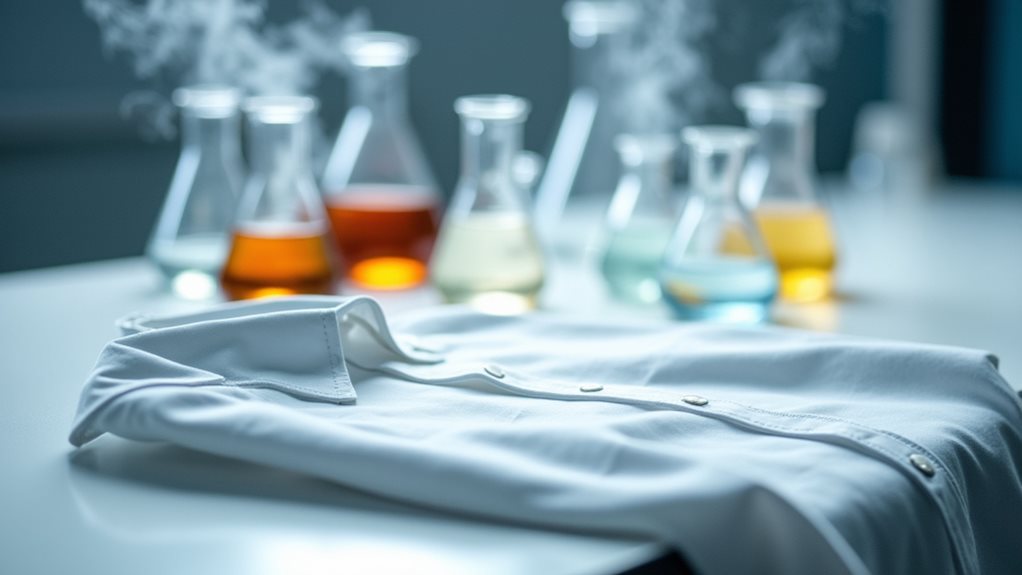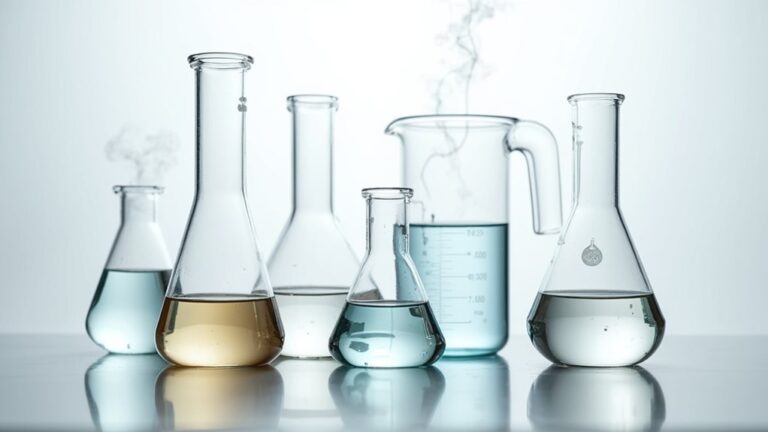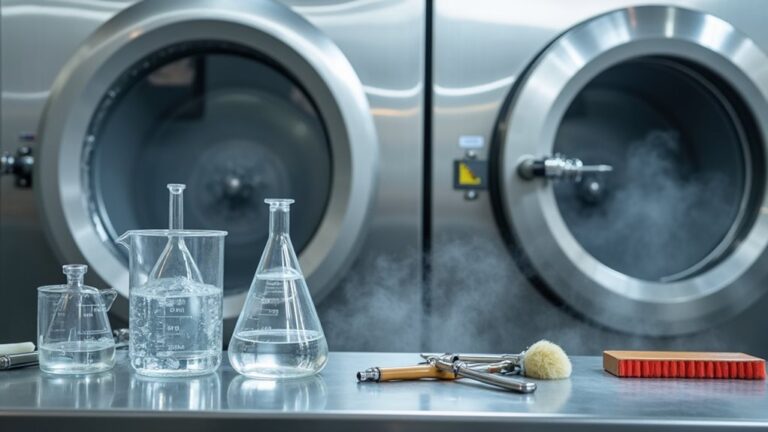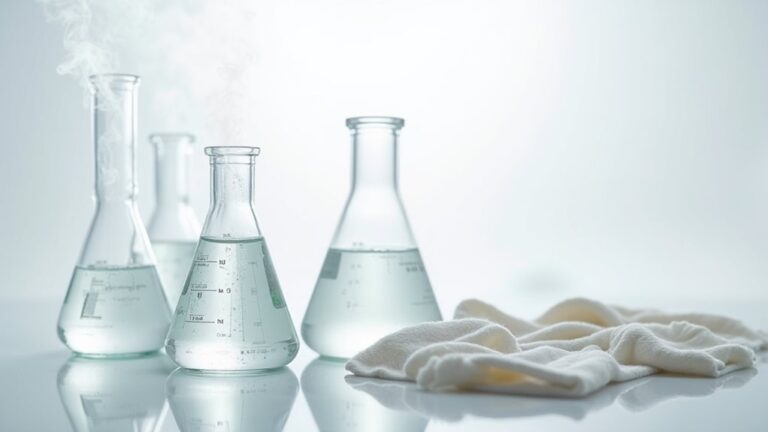Yes, dry cleaning chemicals absolutely cause cancer, and you’re exposed to them every time you handle freshly cleaned clothes. Perchloroethylene (PCE) and trichloroethylene (TCE), the industry’s go-to solvents, are proven carcinogens linked to non-Hodgkin lymphoma, bladder cancer, kidney cancer, and liver cancer. Workers face the highest risks from daily exposure, but even living near dry cleaners increases your cancer risk through chemical vapors and groundwater contamination. Fortunately, safer alternatives exist that’ll protect your health.
The Most Common Carcinogenic Chemicals Used in Dry Cleaning
When I first started researching dry cleaning chemicals, I’ll admit I was shocked to discover that the very solvents making our clothes pristine are the same ones that health experts consider serious cancer risks.
The biggest culprit? Perchloroethylene, commonly called PCE, which the International Agency for Research on Cancer labels as a “probable human carcinogen.”
Then there’s trichloroethylene (TCE), an even more dangerous chemical that’s definitively carcinogenic and linked to kidney and liver cancers.
What really hit me was learning how dry cleaning workers face daily exposure to these toxic substances, experiencing considerably higher cancer rates than the general population.
The Environmental Protection Agency has finally stepped in, implementing regulations to phase out these hazardous chemicals—though honestly, it feels like too little, too late for many workers already affected.
Beyond cancer risks, PERC exposure can cause immediate health effects including dizziness, headaches, and potential damage to the nervous system and liver.
How Perchloroethylene (PCE) Increases Cancer Risk
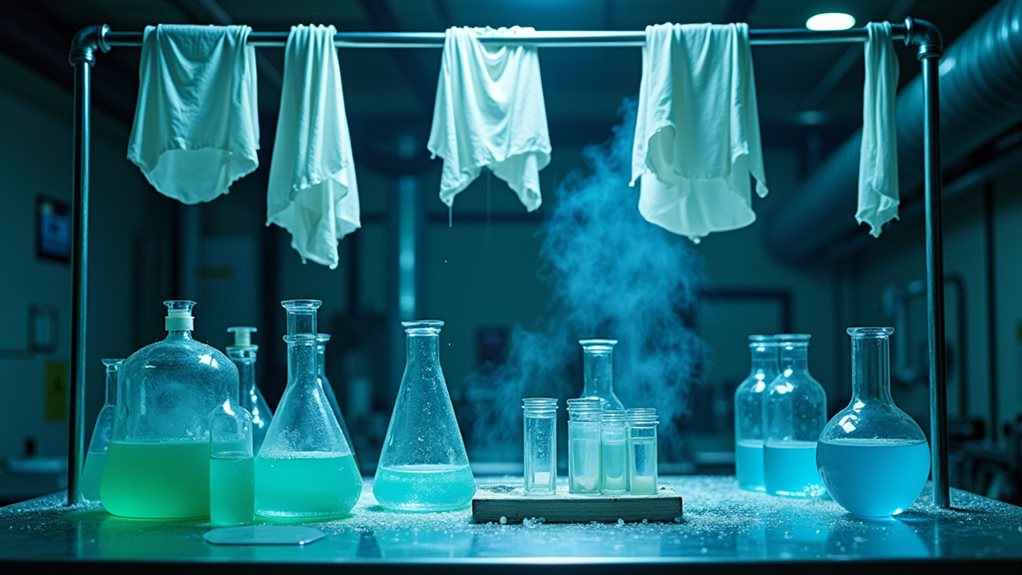
Although I’d always assumed the biggest danger from dry cleaning was accidentally leaving my favorite shirt there for months, the reality about perchloroethylene’s cancer risk is far more sobering than my wardrobe mishaps.
When you’re exposed to this human carcinogen, you’re fundamentally rolling dice with your health, and the stakes aren’t pretty. The dry cleaning industry’s reliance on PCE has created serious cancer risks, particularly for workers who face daily exposure levels that can trigger non-Hodgkin lymphoma, bladder cancer, and multiple myeloma.
Even living near facilities using perchloroethylene puts you at risk—studies show increased kidney cancer rates among nearby residents. The health effects aren’t just theoretical; they’re documented, measurable, and frankly terrifying enough to make me reconsider my dry cleaning habits entirely.
Beyond the cancer risks, PERC residues can remain on your freshly cleaned garments and cause immediate health problems like skin irritation and respiratory issues when clothes aren’t properly aired out before wearing.
Trichloroethylene (TCE) and Its Link to Multiple Cancer Types
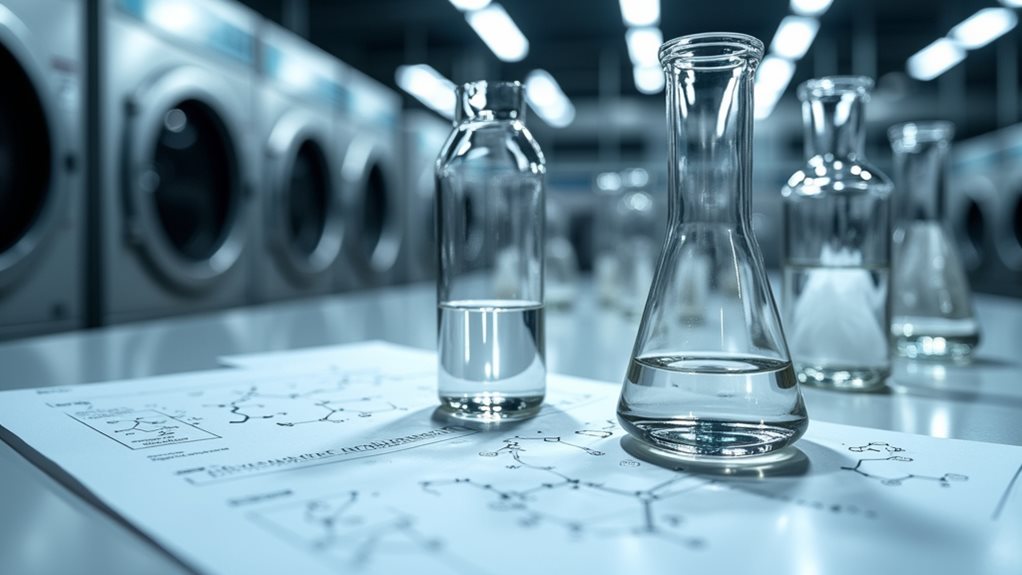
You’ve probably never heard of trichloroethylene, but this sneaky chemical has earned itself a spot on the World Health Organization’s “definitely causes cancer” list 😬, which honestly isn’t the kind of recognition any substance should be proud of.
While PCE gets most of the attention in dry cleaning discussions, TCE quietly poses its own serious threats, particularly when it comes to liver cancer, kidney cancer, and blood cancers like non-Hodgkin lymphoma.
What makes this chemical especially concerning is how it can contaminate groundwater and stick around in the environment for years, meaning your exposure doesn’t necessarily end when you leave the dry cleaner’s shop.
Like other traditional dry cleaning solvents, TCE can also cause neurological symptoms and respiratory irritation from prolonged exposure, affecting both workers in the industry and customers.
TCE Cancer Classifications
Since I started researching dry cleaning chemicals years ago, I’ve been struck by how trichloroethylene (TCE) stands out as one of the most troubling substances in this industry—and honestly, the scientific evidence backing up these concerns is pretty overwhelming.
When you’re looking at cancer classifications, TCE doesn’t mess around: the International Agency for Research on Cancer slapped it with a Group 1 carcinogenic rating, which basically means there’s rock-solid evidence it causes cancer in humans.
The Environmental Protection Agency has labeled it a hazardous air pollutant, and here’s what should really worry you—studies consistently link TCE exposure to kidney cancer, liver cancer, and non-Hodgkin lymphoma.
These aren’t minor health risks we’re talking about; they’re life-threatening conditions that deserve your serious attention.
While TCE poses these serious cancer risks, many dry cleaning facilities are transitioning to safer alternatives like wet cleaning, liquid CO2, and hydrocarbon solvents to reduce health hazards for both workers and consumers.
Liver and Kidney Risks
Looking beyond the broad classification warnings, I’ve spent countless hours digging into exactly how TCE wreaks havoc on specific organs, and what I’ve discovered about liver and kidney damage is frankly terrifying—these aren’t just statistical risks hiding in medical journals, but real, measurable threats to the organs that literally keep you alive.
The research on kidney cancer connections is particularly solid, with this carcinogen showing up repeatedly in studies of affected workers. Your liver faces similar dangers, as occupational exposure data reveals clear links between TCE and hepatic tumors.
What really gets me is that these toxic chemicals don’t stop there—they’re also connected to non-Hodgkin lymphoma, creating a trifecta of health risks that should make anyone think twice.
Blood Cancer Connections
When I first stumbled across the research linking TCE to blood cancers, I’ll admit I’d to read the studies twice because the connection seemed almost too sinister to believe—here’s a chemical that doesn’t just target one type of cancer, but systematically attacks your blood-forming tissues in ways that can fundamentally alter your body’s ability to fight disease.
The IARC’s classification of this dry cleaning chemical as a Group 1 carcinogen specifically highlights non-Hodgkin’s lymphoma as a primary concern, though perchloroethylene (PCE) also poses considerable risks.
What’s particularly troubling is how chemical exposure from these cancer-causing chemicals creates a silent public health crisis, increasing your risk of cancer through contaminated water supplies that affect entire communities near former dry cleaning facilities.
Fortunately, many dry cleaning facilities have begun adopting safer alternatives like liquid CO2 and hydrocarbon solvents to reduce these health risks.
Worker Exposure Risks in Dry Cleaning Facilities
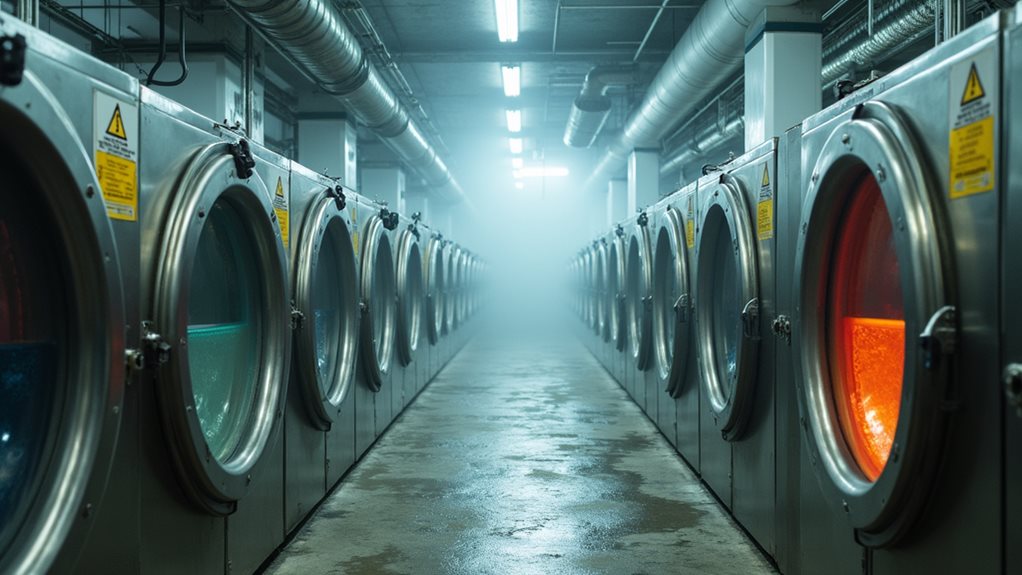
If you’re working in a dry cleaning facility, you’re breathing in a cocktail of volatile organic compounds every single day, and honestly, that’s scarier than any horror movie I’ve ever watched.
Your lungs become unwilling participants in a long-term experiment with chemicals like PCE and TCE, which not only disappear after your shift ends—they accumulate in your body over months and years of exposure.
The harsh reality is that these chemical inhalation dangers create a domino effect of health problems that can follow you home, affecting not only your immediate well-being but potentially setting the stage for serious diseases down the road.
Fortunately, modern dry cleaning facilities are heavily regulated and must implement safety protocols with advanced equipment to minimize worker exposure to these hazardous chemicals.
Chemical Inhalation Dangers
Why do workers in dry cleaning facilities face such alarming health risks, and what makes their daily environment a potential minefield of invisible dangers? The answer lies in the chemical inhalation dangers that surround them every single day.
When you’re working with PCE or perc, you can’t see the toxic substances floating in the air, but they’re there, silently entering your lungs with each breath.
Workers involved in these operations face considerably higher cancer mortality rates—and honestly, that’s terrifying when you think about it. The health risks from prolonged exposure aren’t just statistics on paper; they represent real people developing liver damage, kidney problems, and various cancers simply by showing up to work each day.
Beyond cancer risks, prolonged exposure to perchloroethylene has been linked to neurological problems and reproductive issues that can significantly impact workers’ quality of life.
Long-term Health Effects
As troubling as the immediate inhalation risks are, the long-term health effects paint an even darker picture for dry cleaning workers who’ve spent years breathing in these invisible toxins.
You’re not only dealing with temporary discomfort – decades of PCE exposure fundamentally rewire your body’s cellular machinery, creating a perfect storm for cancer development.
Studies consistently show heightened rates of bladder cancer and non-Hodgkin lymphoma among long-term dry cleaning professionals, while your liver, kidneys, and nervous system bear silent damage that compounds over time.
The chemicals don’t merely disappear after your shift ends; they accumulate, creating a toxic legacy that follows you home.
It’s sobering to realize that your dedication to providing clean clothes comes with such profound health risks.
The EPA and International Agency for Research on Cancer have classified perchloroethylene as a probable human carcinogen, with research also suggesting potential links to esophageal and kidney cancers among industry workers.
Residential and Community Health Impacts From Dry Cleaning Operations
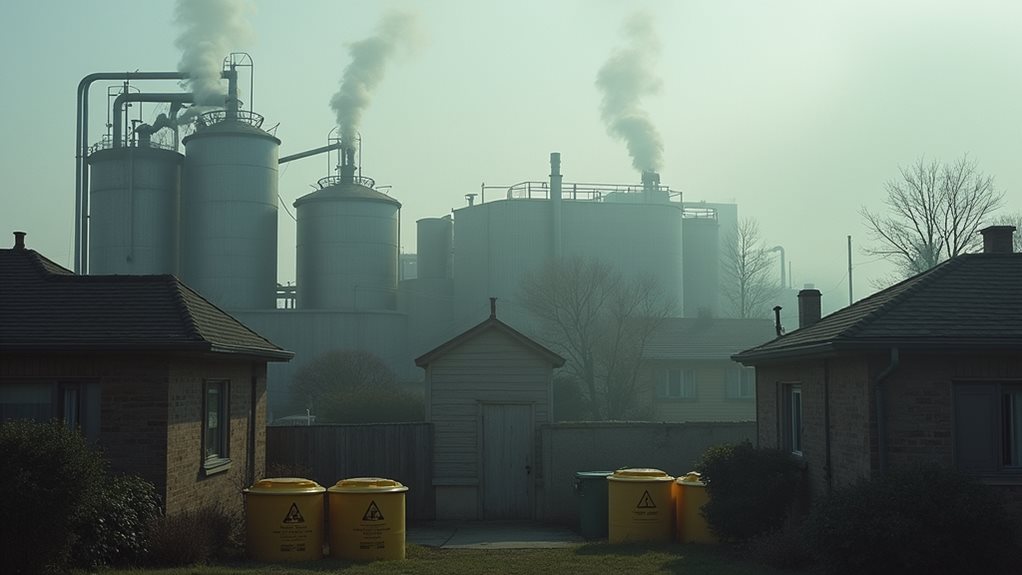
When you live near a dry cleaning shop, you might notice that familiar chemical smell drifting through your neighborhood, but what you can’t see is how those invisible vapors could be quietly affecting your family’s health over time.
Research reveals that residential proximity to operations using perchloroethylene (PCE) increases kidney cancer risks among nearby residents, creating serious community health concerns that extend far beyond the shop’s walls.
These environmental impacts don’t stop at your doorstep—PCE vapors from freshly cleaned clothes continue releasing into your home’s air, while groundwater contamination threatens local water supplies.
Though EPA regulations now ban these chemicals, existing contamination lingers, reminding us that health risks from decades of dry cleaning operations remain a pressing reality for affected communities.
Beyond cancer risks, prolonged exposure to PERC can cause immediate symptoms like dizziness, headaches, and respiratory issues, making it crucial for residents to understand both short-term and long-term health impacts.
Recent EPA Bans on Cancer-Causing Dry Cleaning Solvents
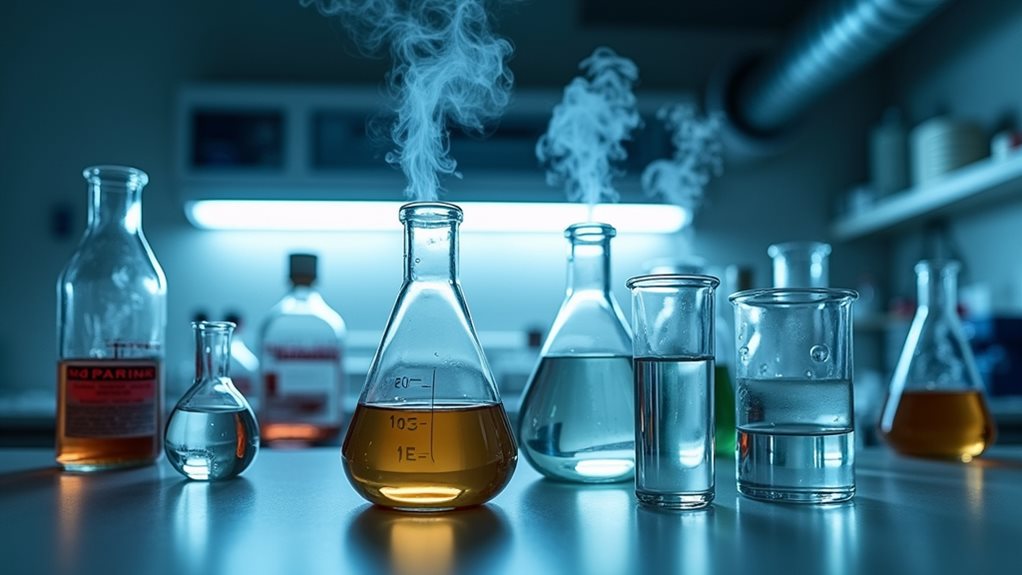
After decades of mounting evidence and community advocacy, the Environmental Protection Agency finally took decisive action on December 9, 2024, announcing extensive bans on trichloroethylene (TCE) and perchloroethylene (PCE), the two notorious cancer-causing chemicals that have dominated the dry cleaning industry for far too long.
While you might think this news arrived like a superhero swooping in to save the day, the reality feels more bittersweet—these EPA restrictions give dry cleaners up to ten years to phase out PCE completely.
The contamination that’s already seeped into our communities will persist for decades, creating a sobering reminder that regulatory action, though absolutely necessary, can’t erase past damage.
This ban represents hope for safer alternatives in dry cleaning, but experts emphasize we need continued vigilance to protect public health moving forward.
Beyond cancer risks, exposure to these chemicals has been linked to neurological problems and reproductive issues, making this regulatory action crucial for protecting both workers and consumers.
Safer Alternative Cleaning Methods and Their Effectiveness

While the EPA’s ban on cancer-causing solvents marks an essential step forward, you might be wondering what exactly your dry cleaner will use instead of those toxic chemicals—and whether these alternatives can actually get your favorite silk blouse or wool suit properly clean.
The good news is that safer alternative cleaning methods have proven remarkably effective, giving you peace of mind without sacrificing quality. Liquid carbon dioxide cleaning removes stubborn stains while being completely environmentally friendly and non-toxic—no more worrying about chemical residues on your clothes.
Wet cleaning uses water and biodegradable detergents, dramatically reducing hazardous solvent exposure for both workers and customers.
Though some fabrics require special consideration and cleaners need equipment investments, these methods deliver excellent results while protecting your health.
Protecting Yourself From Dry Cleaning Chemical Exposure
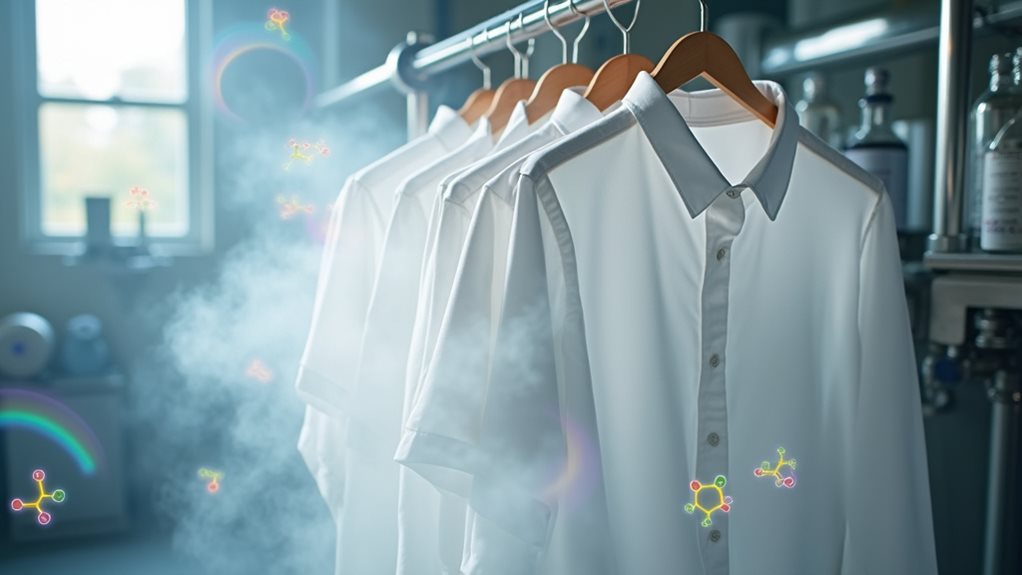
Nobody wants to play chemical roulette with their health, especially when a simple conversation with your dry cleaner can dramatically reduce your exposure to cancer-causing solvents.
A quick chat with your dry cleaner could be the easiest step you take to protect your family from toxic chemicals.
I’ve learned that protecting yourself from perc and other environmental health risks doesn’t require a chemistry degree, just smart choices and a few proactive steps.
Here’s your game plan for staying safe:
- Ask about cleaning products – Request liquid carbon dioxide or wet cleaning alternatives to perc
- Air out garments outdoors before bringing them inside your home
- Never leave dry-cleaned clothes in hot cars or enclosed spaces
- Consider home laundering for many “dry-clean-only” items
Most dry cleaners appreciate customers who care about safety, and many already offer eco-friendly alternatives that clean just as effectively.

